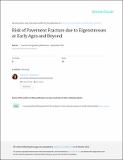Risk of Pavement Fracture due to Eigenstresses at Early Ages and Beyond
Author(s)
Louhghalam, Arghavan; Ulm, Franz-Josef
DownloadUlm_Risk of Pavement Fracture.pdf (2.034Mb)
OPEN_ACCESS_POLICY
Open Access Policy
Creative Commons Attribution-Noncommercial-Share Alike
Terms of use
Metadata
Show full item recordAbstract
Tensile cracks significantly affect the durability of concrete pavements, leading to an increase in the costs of maintenance and rehabilitation. A model is developed that relates thermal, chemical, and hygral evolutions at small scales due to different distress mechanisms to the risk of fracture at the structural scale. The method is based on application of linear elastic fracture mechanics (LEFM) to eigenstresses that develop in infinite- and finite-length beams on an elastic foundation that represents the subgrade. Axial and bending contributions to the energy release rate are determined for a worst-case scenario of an entirely cracked pavement section in functions of material properties, structural dimensions, and eigenstress forces and moments. By way of example, the model is used to study the risk of fracture of concrete pavements due to two different mechanisms: (1) autogeneous shrinkage at early ages of placing the concrete and (2) thermal cycles at the short term and long term after a temperature change. In addition, scaling relationships are developed that provide insight into the improvement of different structural and material properties for minimizing the risk of fracture.
Date issued
2016-09Department
Massachusetts Institute of Technology. Department of Civil and Environmental EngineeringJournal
Journal of Engineering Mechanics
Publisher
American Society of Civil Engineers (ASCE)
Citation
Louhghalam, Arghavan, and Franz-Josef Ulm. “Risk of Pavement Fracture Due to Eigenstresses at Early Ages and Beyond.” Journal of Engineering Mechanics 142, no. 12 (December 2016): 04016105.
Version: Author's final manuscript
ISSN
0733-9399
1943-7889